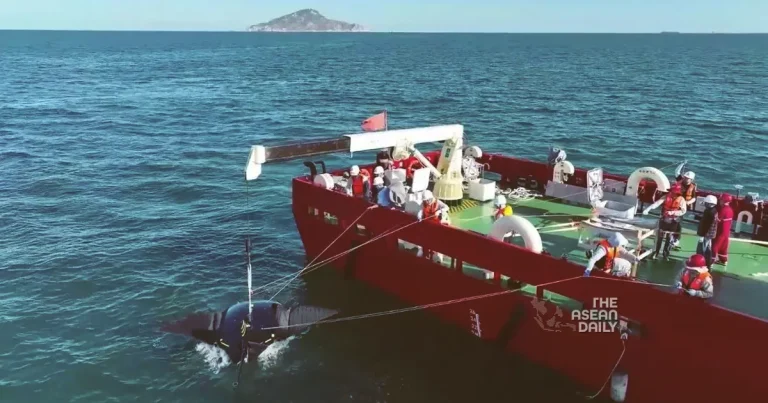10-6-2024 (BEIJING) The Chinese government is rapidly expanding its fleet of manta ray-inspired submersible drones, with plans to develop larger models capable of conducting reconnaissance and strike missions in the future.
Originally designed for monitoring coral reefs, these soft-bodied submersibles mimic the swimming patterns of manta rays, enabling them to navigate the ocean depths with remarkable agility. The earlier versions, some whimsically painted to resemble cartoon characters, were small and lightweight, built specifically for studying marine life. However, recent developments signal a shift towards more ambitious goals.
Cao Yong, a professor at Northwestern Polytechnical University, revealed that the team is preparing to construct submersibles weighing up to 800 kilograms (1,765 pounds) this year. “We will even develop a tonne-class prototype in the future, which can carry more powerful payloads and sail farther, including… future integrated reconnaissance and strike [roles],” he stated, hinting at the potential military applications of these advanced submersibles.
The project began in 2006 when Cao’s team embarked on developing a submersible for coral reef monitoring, drawing inspiration from the graceful movements of marine organisms. Their efforts paid off as they successfully deployed their creations in the South China Sea earlier this year, monitoring the proliferation of species like the crown-of-thorns starfish, which pose a threat to coral reefs.
While the smaller submersibles serve educational and monitoring purposes, the larger models can dive deeper and longer, collecting more valuable data. Each submersible is designed with space for additional equipment, and the team plans to deploy them in clusters next year to maximize their capabilities.
In a first, China has achieved monitoring of coral reef growth in #SouthChinaSea using a self-developed bionic soft-bodied #submersible. The smart manta ray #robot has so far completed 200+ operations, marking a milestone in bionic underwater equipment application in the country. pic.twitter.com/biD5MESyFb
— China Science (@ChinaScience) April 16, 2024
“The endurance, load capacity, and range of a single unit are all very limited. If we form a cluster, we can travel longer distances,” explained Hao Yiwei, a researcher at Northwestern Polytechnical University.
China is not the only country exploring the potential of manta ray-like submersibles. Earlier this year, the United States conducted successful in-water tests of a similar underwater drone developed by defense technology company Northrop Grumman. The autonomous vessel is designed for “long-duration, long-range missions in ocean environments where humans can’t go,” according to the company. It can anchor to the sea floor and hibernate in a low-power mode, carrying payloads for various missions.
The U.S. Defense Advanced Research Projects Agency (DARPA), which commissioned the drone, envisions “providing groundbreaking technology to create strategic surprise,” highlighting the potential military applications of such advanced submersibles.
China’s manta ray submersibles are equipped with cameras, sonar, and the BeiDou navigation system, allowing them to transmit real-time video and positioning information back to researchers. Last year, one of the vessels reached an impressive depth of 1,000 meters (600 feet), according to CCTV.
While the team is not concerned about shark attacks, they are exploring ways to prevent microorganisms from attaching themselves to the submersibles’ surfaces, which could impede navigation. One solution under consideration is the application of a special gel that would trick the microorganisms into believing the submersible is seawater.




